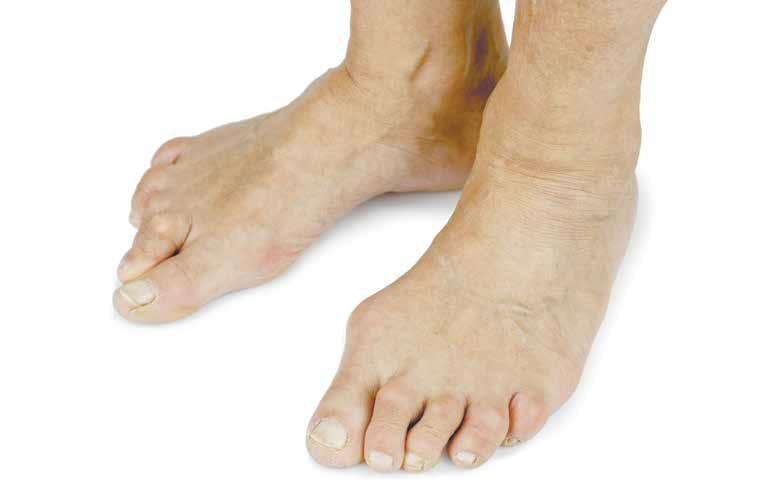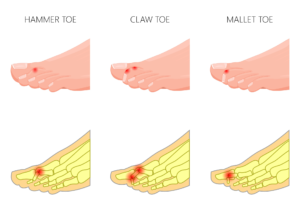
So you’ve developed a hammertoe – or maybe you’ve noticed that your child’s toes are starting to curl. So what can you do about it? Should you do anything about it? What if there’s no pain – is it fine to leave them?
Today, Auckland’s premier podiatry team, Perform Podiatry, talks about the causes and treatment of curly toes.
What are the different kinds of curly toes?
Hammertoes, claw toes and mallet toes are the three most common kinds of ‘curly toes’. These are medically known as clinodactyly, which translates to the ‘curvature of a digit’. The difference between the three lies in which joints the curvature is found and in which direction it is occurring. The lesser toes contain three joints – one at the ball of the foot and two within the toe. Here are the differences between the three conditions:

What causes these changes to the toe shape?
We have muscles and tendons running across the toes and attaching to the joints. When these muscles and tendons pull on the toe (which can happen from various causes), an imbalance occurs and the joint moves, curling the toe upwards or downwards. While these changes may be flexible at first, over time, the joints can become stiff and rigid. The causes of the imbalance may be:
-
- The length of your toes – a common place for a hammertoe is at the second toe, when the second toe is longer than the big toe
- Footwear – wearing tight or narrow shoes where your toes bump against the end of the shoes or are kept in a bent position can cause the toes to curl permanently
- Toe injuries – when your toes or feet are injured, curly toes are more likely to develop
- Poor foot posture or alignment
- Arthritis and other medical conditions – when you have medical conditions that affect the joints, the toes may be more likely to curl
Do curly toes cause pain?
While the changes to the joint shape and position do not typically cause pain, the resulting position of the toes can lead to painful complications. These include corns, callus, blisters, thickened nails or nail damage, metatarsalgia (forefoot pain), and difficulty fitting closed-toe shoes comfortably.
This is a particular risk for those with diabetes or issues with circulation, as they are more likely to develop ulcers from areas of friction on the toes as a result of curled toe shape.
How are curly toes treated?
Curly toes fall into two distinct categories – those that are still flexible and may respond to treatment, and those that are stiff and will not respond to regular care. For those that are stiff, the goal is to keep your feet as comfortable as possible while reducing the risk of the complications we mentioned above. This can be done by wearing shoes with a wide toe box, using devices to offload the toes, and caring for any corns, calluses or other problems that arise.
For curly toes that have recently developed and are still flexible, we have a range of toe props and other devices that can be worn to encourage the toes to straighten. The best device will depend on which toes and joints have been affected.
Is your goal to get back to straight toes and comfortable feet?
Then our experienced podiatrists here at Perform Podiatry are here to help. Book an appointment by calling 09 523 2333 or book online here.

We’ve all heard how most of us have one foot that is slightly longer than the other. It may be an unnoticeable difference, or it may be half a shoe size – or more. Well, the same goes for the length of our legs! Whether it’s our femur (thigh bone), our tibia (shin bone), or tight muscles that are causing an apparent shorter leg when we walk, many of us will have a shorter leg and not even know about it. But what does this mean? And will it cause any symptoms or pain?
Today, the Perform Podiatry team are talking all about how leg length differences can cause a great deal of pain without you even knowing what is going wrong.
How limb length differences cause you pain
Picture yourself standing straight with one leg being longer than the other. The short leg will be completely straight, and the longer leg will have to bend slightly to compensate for the difference. Your pelvis will be tilted, and the stabilising muscles and ligaments around your hips and pelvis will eventually get used to this tilted position and adjust accordingly. The muscles and alignment of your back will be affected, and the way that you walk will be affected. The longer left leg will have to perform a compensatory movement when it straightens to avoid hitting down into the ground as you walk. You may hike your hip upwards or move the leg out and around as you swing through your step.
As your body compensates and starts moving and using muscles differently, your risk for straining and overloading muscles and joints increases. For those whose leg length differences are big enough to cause symptoms, they may experience:
- Hip pain
- Back pain
- Knee pain
- Muscular strain and tendinopathies
- Uneven loading and pressure distribution between the legs
 How big does the difference need to be to cause pain?
How big does the difference need to be to cause pain?
There is no universal value for how many millimetres of difference causes you pain. It varies from person to person and depends on your body, too.
In our clinic, when we suspect a limb length difference because a patient has come to us with pain, we usually measure a difference of at least ~6mm. With this said, we’ve also seen patients with a 6mm that don’t experience any symptoms.
To confirm that you have a limb length difference, after identifying a notable difference in our clinic (we wouldn’t classify anything less than 3-4mm as ‘notable’), we then refer you for a scan where your bone lengths will be measured radiographically. You’ll receive the precise difference in limb length, and this will help to direct your treatment.
What can be done to help painful leg length differences?
Treating a leg length difference includes both helping to correct the difference, and treating any problems that it has already caused. We start with a comprehensive biomechanical assessment to find out exactly what muscles have been affected so that we know how to best direct your treatment.
We often use custom-prescribed orthotics to help correct the difference by adding a raise to the orthotic for the shorter leg. This helps to equalise the leg length when wearing the orthotics and bring the pelvis and joints back into alignment. We can also make modifications to your shoes to add height to the shoe on the shorter leg.
We’ll then work to help rehabilitate any painful and strained muscles that have become damaged because of the leg length difference. Our goal is to help you stay healthy, happy and pain-free not just now but also for the years to come.
To book an appointment with one of our experienced Podiatrist, you can call us on 09 523 2333 or book online here. We’re located at the One Health building on Remuera Road, just up from Broadway, Newmarket.



 How big does the difference need to be to cause pain?
How big does the difference need to be to cause pain?